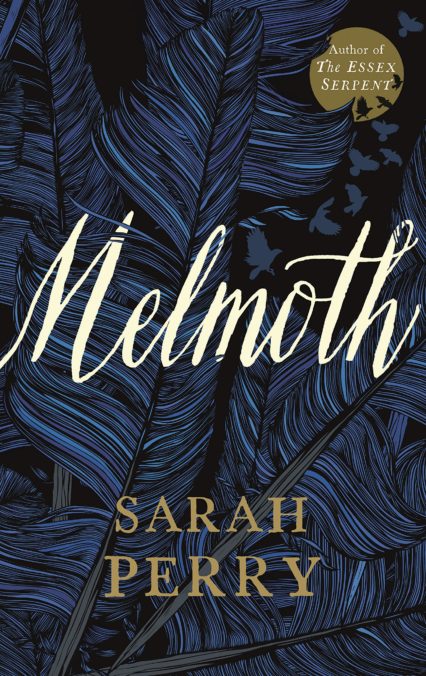In the run up to the announcement of the winner of this year’s International Dylan Thomas Prize, Wales Arts Review will be publishing reviews of the six shortlisted titles, written by the students of the IDTPrize module at Swansea University. Next up is a joint review of Sarah Perry’s novel, Melmoth (Serpent’s Tail) by students Molly Holborn, Angharad Stephens and Hannah Wadham.
The module is the first English academic study in the world dedicated to a major literally prize and includes access for the students to authors and members of the publishing industry who run tutorials on subjects ranging from book marketing and publicity, to book prize logistics and sales in publishing to help students to explore how literary prizes help to produce, promote and celebrate contemporary writing.
 Award-winning novelist Sarah Perry’s third novel Melmoth is a fantastical and gothic reinvention of Charlies Maturin’s classic Melmoth The Wanderer (1820). Her style continues from her best-selling novel The Essex Serpent (2017) with a range of narrative voices and harrowing journeys that are within our history. The novel begins with the main character, Helen Franklin a translator who is given a mysterious manuscript that holds the accounts of the appearance of a ghostly woman, Melmoth.
Award-winning novelist Sarah Perry’s third novel Melmoth is a fantastical and gothic reinvention of Charlies Maturin’s classic Melmoth The Wanderer (1820). Her style continues from her best-selling novel The Essex Serpent (2017) with a range of narrative voices and harrowing journeys that are within our history. The novel begins with the main character, Helen Franklin a translator who is given a mysterious manuscript that holds the accounts of the appearance of a ghostly woman, Melmoth.
These accounts range from Josef Hoffman’s growing up during a Czechoslavakian war to a Turkish beggar witnessing the Armenian massacre, all of which contain sightings of Melmoth. As the manuscript is read, Perry begins a climactic and harrowing journey of the curse of Melmoth and the historical periods for which she is cursed to witness for the sin she has committed, alongside Helen’s own journey of loneliness and burden.
Set in bohemian Prague, the characters meet in small secluded cafe’s behind velvet curtains telling the untold secrets of Melmoth. In every character’s background, there lies a horrific event, this is what fuels the plot and justifies Melmoth’s curse. Sarah Perry’s writing style flows easily between time periods and through completely unique voices and characters, it takes on a journey through time and moments of painful change.
During an interview with Sarah Perry, she said that her main driving force for the novel was for the readers to find out what Helen Franklin did. The frequent changes in narration prove to be successful in driving the reader forward, discovering the myth of Melmoth and answering the underlying questions about Helen’s life and what this seemingly ordinary woman has done. With each section of the novel alternating between modern-day Prague with Helen and manuscripts on Melmoth written as far back as the 1600s; It is clear that Perry has put effort into this element of her narratives within Melmoth. Each part is packed full of information to take in, however, it still remains effective in pushing the reader to follow Helen’s story. Perry stated that she wanted the readers to want to keep coming back to Helen’s story.
From the first part of the novel Perry draws the reader in by introducing this character who’s from Essex, living in Prague as a translator and sleeping in a sparse bedroom that is nothing but a bare mattress: ‘… you would see a room, which is also white-painted, plain. A narrow bed… a small plain desk, and a small plain chair… the walls and mattress are bare’.The plainness of Helen’s space and the way Perry builds her character is arguably what drives the question of what Helen did, paired with the feeling of being watched and the interchanging of modern day and historical observations of Melmoth are what ultimately drive the novel to be so successful.
Unlike other authors, Perry’s research for this novel was not traditional, although she has written a novel that relies on many aspects of history. However, her unconventional method ensures that the references that she makes to the different time periods are accurate to both history and the novel’s plot, whilst bringing traits typically found in Victorian gothic literature into the modern day. The connection to literature such as Brontë’s Jane Eyre, which Perry read at the age of 8; is prominent from the velvet curtains to the small table in the dark corner. The lack of monstrous female characters literature is something commented on by Perry as an issue that she noted as a child. There are characters in literature that fulfill the hole that Perry noted, such as Grendel’s unnamed mother, and Bertha as the madwoman in the attic. Both these characters, although monstrous are not the villains that they could have been in their narratives, and are still subdued by the men around them, therefore, they are not able to properly fulfill their purposes in their respective texts. Perry has envisioned a solely monstrous character, that in Maturin’s text was a male character; that has no form of male oppression and perfectly performs her role within the narrative. Perry has been able to seamlessly create a gothic world situated in a bohemian setting such as Prague, whilst retelling an age-old story of loneliness and morality.










